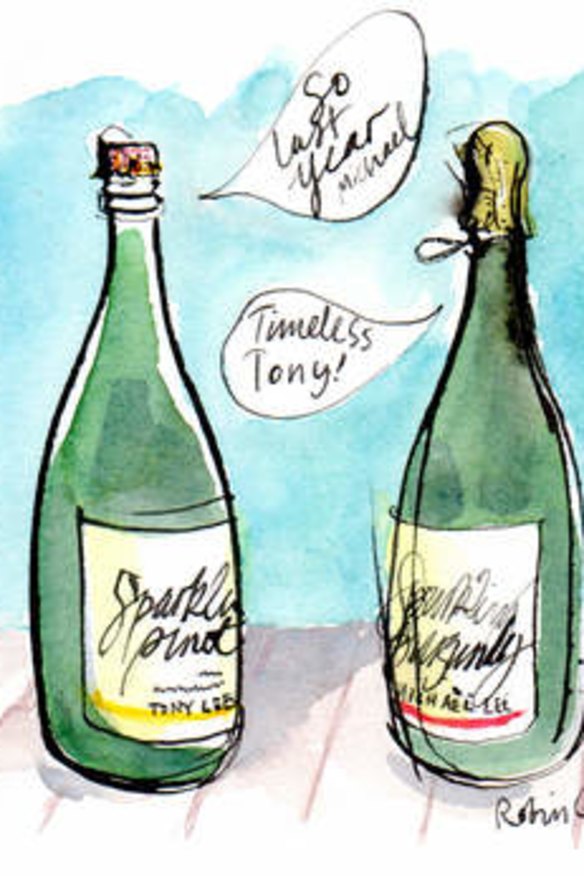Seeking a seal of mutual approval
Another vintage, another debate over the ideal bubbly bottle stopper.

GROWING UP IN THE suburbs of Melbourne in the 1970s, my older brother and I shared a bedroom, a vinyl record player and a taste for surfing at weekends. We did the same degree at the same university and we bought our first tiny enterprise - a cafe serving toasties - together.
Then, as now, people often assumed that because we were in business together, we agreed about everything. The truth is, we have irreconcilable differences. Although we co-own a winery - it's our fifth business together - my brother cannot come to terms with my penchant for schlock films such as Shaun of the Dead. I, meanwhile, still struggle with the fact that he once paid good money for the soundtrack to Ally McBeal.
When he drives the winery ute, he tunes the radio to an FM station featuring big-haired, anthemic rockers and pop ballads that are almost as old as I am. When I drive it, I turn the dial back to Triple J. Every year, when we're about to run out of composite corks to seal our sparkling wines, Mike and I have what a politician might call a ''robust discussion'' about whether to order more corks or to opt, instead, for crown seals. He favours corks. I want crown seals.
Crown seals are not glamorous, but they are good at keeping bubbles in bottles. And they are not corks. How do I hate corks? Let me count the ways. As a winemaker, I have hated spending months tending the vineyard before pressing the grapes, ageing the juice in extortionately expensive French barrels and bottling something that tastes good, only to have the flavour wrecked by a contaminated piece of bark grown in southern Europe.
When our winery still relied on corks for all our wines, I reckon as many as 15 per cent of our bottles were damaged by faulty corks. As a wine drinker, I hate the hassle of sending back wine in a restaurant. I also hate pulling the cork on a much-anticipated bottle at home, only to find that it smells of dirty socks. Yes, I know I can take it back to the retailer and have it replaced - but it's annoying. None of this happens to me often these days because we seal all our still wines with screw caps. When I'm buying other people's wine, I avoid corks. But our winemaking brethren in Europe are more attached to the old ways.
I've heard the wine industry conspiracy theory that Portuguese cork suppliers save their best corks for Old World winemakers who've been buying their product for centuries, and ship the lower-grade ones to us, the johnny-come-lately types in the colonies. If this is so, French wines sealed with corks should have lower rates of cork contamination than Australian ones. Having recently spent the best part of a fortnight drinking nothing but French wine, I am ready to give this theory all the credence it deserves - not much.
On holiday in New Caledonia, on my first night at a Noumea hotel restaurant, I ordered a glass of sancerre. When it arrived, it smelt more like a squash court changing room than sauvignon blanc. Unable to remember the French for ''corked'', I gestured unhappily and pointed at my nose several times. Our waitress replaced the glass with one poured from a fresh bottle, which was fine.
We weren't so lucky in the days that followed. Of the bottles we'd bought to tide us through a week on a hired yacht, two were badly corked: one a dessert wine, one a pricey premier cru chablis. When you're anchored off an uninhabited island 40 nautical miles from the nearest bottle shop, picking up a replacement is tricky.
So when I returned home to the winery and Mike reminded me that it was time to order more corks for our sparkling wines, I put to him my annual proposition: how about crown seals instead? Champagne bottles - here and in Europe - are no strangers to the humble beer-bottle cap. Almost any wine made by the traditional method - where the wine is fermented in a bottle instead of being gassed up in a tank - spends up to three or more years maturing under crown seal while still in the winery.
The cork - and its wire ''cage'' and the decorative foil that covers it all - appears only in the final stages of production, after the crown seal is removed to allow the wine to receive its ''dosage'' of sugar. You could replace the old crown seal with a new one and the wine would be every bit as good.
Sparkling specialist Domaine Chandon is among several Australian producers to have sold high-quality sparklings under crown seals. Why shouldn't we? Well, as Mike points out, we're not at much risk of cork taint. We use a composite cork called a Diam, which has been pummelled into pieces and supposedly cleaned of impurities before being shaped into a champagne cork. I admit I've never seen cork taint in one of these.
But what is perhaps the real issue is that for many people, the ritual of unwrapping the foil, twisting off the cage and popping the cork is almost as important as what's in the bottle. Call it pop culture: this round goes to Mike. For this year at least, we'll continue to bottle our bubbles under cork.
Tony Lee makes wine for Foxeys Hangout at Red Hill.